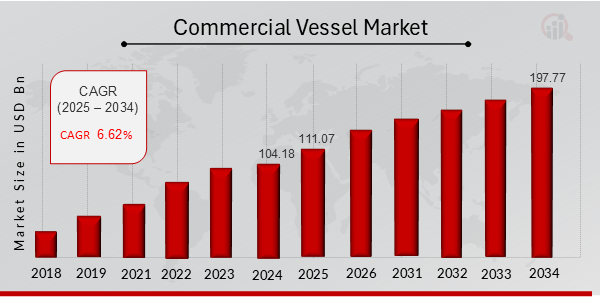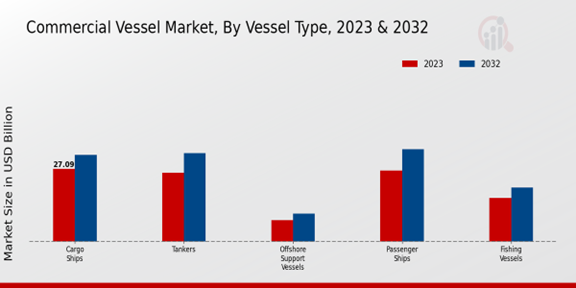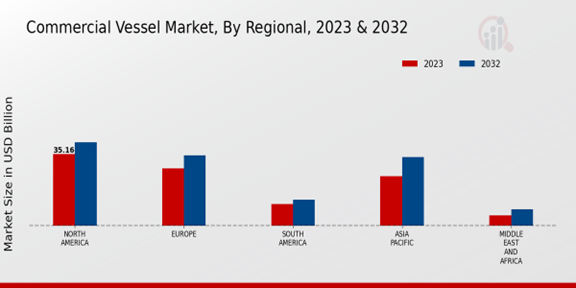Commercial Vessel Market Overview:
As per MRFR analysis, the Commercial Vessel Market Size was estimated at 104.18 (USD Billion) in 2024. The Commercial Vessel Market Industry is expected to grow from 111.07 (USD Billion) in 2025 to 197.77 (USD Billion) till 2034, at a CAGR (growth rate) is expected to be around 6.62% during the forecast period (2025 - 2034).
Key Commercial Vessel Market Trends Highlighted
The commercial vessel market faces significant headwinds and opportunities. Key drivers include increasing global trade, rising marine tourism, and growing demand for offshore wind energy. Environmental regulations and technological advancements also play a vital role.Opportunities abound in the growing demand for specialized vessels, such as tankers, bulk carriers, and container ships, to support the burgeoning e-commerce and logistics industries. Technological advancements like autonomous navigation, hybrid propulsion systems, and IoT-enabled fleet management present opportunities for efficiency gains and cost reductions.Recent trends include the increasing adoption of digital technologies, the emergence of new ship designs optimized for fuel efficiency and emissions reduction, and the growing focus on sustainable shipping practices. Governments and industry leaders are collaborating to develop regulations and incentives to promote decarbonization and green shipping initiatives, creating opportunities for providers of low-carbon solutions and technologies.

Source: Primary Research, Secondary Research, MRFR Database and Analyst Review
Commercial Vessel Market Drivers
Increasing Global Trade and Globalization
Global trade and globalization drive the commercial vessel market. More and more, businesses and consumers want to ship goods and services worldwide and get products from another side of the world. Consequently, much stress is placed on the effectiveness and reliability of shipments. The use of commercial vessels is increasing, and it is possible to say that it will keep growing in the future. The growing middle class in such countries as China and India, technological advancements that make transportation cheaper and more affordable, the growing number of multinational corporations, and other factors are the main drivers of global trade and globalization.At the same time, the significance of transportation is more and more obvious, mentioned, and demand for commercial vessels keeps growing.
Impact of global trade and globalization on the commercial vessel market: Increased demand for commercial vessels; Growing demands for the size of ships and their efficiency related to the growing volumes of trades; Growing demand for specialized ships and vessels, including container ships, tankers, bulk carriers, and other; The growing number of ports and routes; Growing competition.Regardless of the type and kind of transportation businesses, it is possible to say that the global trends in global trade and globalization are basic drivers of the commercial vessel market. The demands to carry more goods and more raw materials make the development of trade even more intensive, and the role of contemporary as well as advanced watercraft becomes crucial.
Technological Advancements
Another driving factor of the commercial vessel market is technological advancements. New technologies have allowed the production of more efficient, environmentally friendly vessels that are cheaper to operate. In addition to that, new designs and propulsion methods were made possible by technological development. The use of new materials in vessel construction is one example of technological advancement. Different types of vessels might benefit from cabin aluminum, Magnesium, Boron, Lithium, and composites in the future.Another example is the development of more efficient engines and propulsion techniques. Some in the industry claim that the future entails the application of tile technology from Space-X rockets onto cargo ships. New methods of automation and robotics are also expected to shape future vessel operations. Finally, new navigation and communication techniques and big data analysis will be used to continue vessel development. Improved technology is expected to lead to reduced shipping company costs, improved vessel performance, and added safety and reliability.More new vessel designs will likely be developed as the High Street model becomes cheaper, fostering a rise in demand for specialized vessels. Thus, technological growth has and will continue to deeply impact the commercial vessel market.
Growing Environmental Concerns
Growing environmental concerns have also been a major driver of the commercial vessel market. As governments and consumers become more aware of the environmental impact of shipping, there has been a growing demand for more sustainable vessels. This has led to the development of new vessel designs and propulsion systems that are more environmentally friendly. Factors contributing to growing environmental concerns: Increased awareness of the environmental impact of shipping Government regulations aimed at reducing emissions from ships Consumer demand for more sustainable products and services The rise of the green economy Impact of growing environmental concerns on the commercial vessel market: Increased demand for more environmentally friendly vessels Development of new vessel designs and propulsion systems Growth in the market for alternative fuels Increased investment in renewable energy sources Development of new technologies to reduce emissions from ships Overall, growing environmental concerns are a major driver of the commercial vessel market, and this trend is expected to continue in the coming years.
Commercial Vessel Market Segment Insights:
Commercial Vessel Market Vessel Type Insights
The Global Commercial Vessel Market is segmented by Vessel Type into Cargo Ships, Tankers, Offshore Support Vessel, Passenger Ship, and Fishing Vessel. According to this segmentation, Cargo Ships held the largest market share in 2023, and the segment contributed to around 38.3% of the Global Commercial Vessel Market revenue. The major growth driver for this segment is the continuously increasing demand for seaborne trade, which is an increasing demand for bulk commodities, including iron ore, coal, grains, etc. The tankers, which are primarily used to carry liquid cargoes such as oil, gas, and chemicals, can be expected to grow at a steady pace in the next few years.The growth driver for this segment is the increasing energy demand and the increasing number of exploration and production activities in offshore regions. The specialized vessel used to support offshore oil and gas production, and exploration is the Offshore Support Vessel. The increasing number of investments in exploration and production requirements is the expected growth driver for this segment. Passenger Ships include cruise ships, ferries, and other ships meant for passenger transport, and the segment can be expected to grow at a moderate pace because of the growing popularity of cruise tourism and the increasing demand for ferry services.The Fishing Vessel category includes the vessels involved in commercial fishing activities, and the expected growth driver for this segment is the increasing demand for seafood and the increasing investments in fishing fleets.

Source: Primary Research, Secondary Research, MRFR Database and Analyst Review
Commercial Vessel Market Propulsion System Insights
Diesel-fueled engines account for the major portion of the Commercial Vessel Market revenue. The Global Commercial Vessel Market is segmented by Propulsion System into Diesel-Fueled Engines, Electric Propulsion, Hybrid Propulsion Systems, Gas-Powered Engines, and Nuclear Propulsion. Among these, diesel-fueled engines dominate the market due to their high power density, reliability, and cost-effectiveness. Electric propulsion is gaining traction, particularly for small and medium-sized vessels, as it offers lower operating costs and reduced emissions.Hybrid propulsion systems combine diesel engines with electric motors to optimize fuel efficiency and reduce emissions. Gas-powered engines are expected to witness modest growth due to their lower emissions compared to diesel engines, while nuclear propulsion remains a niche segment due to its high cost and regulatory challenges. The Global Commercial Vessel Market is experiencing steady growth, driven by factors such as increasing maritime trade, growing offshore activities, and rising demand for specialized vessels.
Commercial Vessel Market Vessel Size Insights
The Vessel Size segment of the Global Commercial Vessel Market is categorized into Small (3,000 DWT), Medium (3,000-10,000 DWT), Large (10,000-50,000 DWT), and Very Large (>50,000 DWT). In 2023, the Small vessel size segment held the largest market share, accounting for approximately 45% of the Global Commercial Vessel Market revenue. The Medium segment is projected to exhibit the highest growth rate during the forecast period, driven by the increasing demand for vessels in the 5,000-10,000 DWT range for coastal and short-sea shipping. The Large and Very Large segments are expected to maintain a steady growth rate due to the growing demand for bulk carriers and tankers for international trade.Overall, the Vessel Size segment is expected to contribute significantly to the growth of the Global Commercial Vessel Market in the coming years.
Commercial Vessel Market End-Use Industry Insights
The Global Commercial Vessel Market is segmented by End-Use Industry into Transportation and Logistics, Offshore Oil and Gas, Mining and Construction, Tourism and Leisure, and Fishing and Aquaculture. The Transportation and Logistics segment is expected to hold the largest market share in 2023, owing to the increasing demand for commercial vessels for the transportation of goods and commodities. The Offshore Oil and Gas segment is projected to witness significant growth over the forecast period, driven by the rising demand for offshore exploration and production activities.The Mining and Construction segment is also anticipated to contribute to the market growth, supported by the increasing demand for commercial vessels for the transportation of raw materials and equipment. The Tourism and Leisure segment is expected to experience steady growth, driven by the rising popularity of cruises and recreational boating. The Fishing and Aquaculture segment is projected to grow at a moderate pace, supported by the increasing demand for commercial vessels for fishing and aquaculture activities.
Commercial Vessel Market Regional Insights
The regional segmentation of the Global Commercial Vessel Market offers insights into the market's geographical distribution and growth prospects. North America is expected to dominate the market in 2023, with a revenue of 34.1 (USD Billion). Europe is projected to follow, with a revenue of 27.2 (USD Billion). The APAC region is anticipated to exhibit significant growth, reaching a revenue of 23.6 (USD Billion) by 2032. South America and MEA are expected to contribute to the market's growth, with revenues of 10.2 (USD Billion) and 4.9 (USD Billion), respectively, in 2032.This market segmentation data provides valuable insights for businesses operating in the Global Commercial Vessel Market, enabling them to tailor their strategies to specific regional markets and capitalize on growth opportunities.

Source: Primary Research, Secondary Research, MRFR Database and Analyst Review
Commercial Vessel Market Key Players and Competitive Insights:
Major players in the Commercial Vessel Market industry are continuously introducing technologically advanced and efficient Commercial Vessel Market solutions to cater to the evolving demands of customers. Leading Commercial Vessel Market players are focusing on strategic partnerships, acquisitions, and collaborations to expand their presence and strengthen their market position. The Commercial Vessel Market industry is expected to witness significant growth in the coming years, driven by increasing demand for efficient and sustainable transportation solutions. The competitive landscape of the commercial vessel market is characterized by the presence of several established players, as well as new entrants emerging with innovative offerings.
Hyundai Heavy Industries (HHI) is a leading player in the Global Commercial Vessel Market. The company is headquartered in Ulsan, South Korea, and has a global presence with shipyards and offices in various countries. HHI offers a wide range of commercial vessels, including container ships, tankers, bulk carriers, and offshore vessels. The company is known for its advanced shipbuilding technology and commitment to innovation.Daewoo Shipbuilding Marine Engineering (DSME) is a major competitor in the Global Commercial Vessel Market. The company is headquartered in Seoul, South Korea, and has a global presence with shipyards in South Korea, Vietnam, and Romania. DSME offers a wide range of commercial vessels, including container ships, tankers, bulk carriers, and gas carriers. The company is known for its design capabilities and engineering expertise.
Key Companies in the Commercial Vessel Market Include:
- Austal
- Fincantieri
- Daewoo Shipbuilding Marine Engineering
- STX France
- Huntington Ingalls Industries
- Samsung Heavy Industries
- Damen Shipyards
- Babcock International Group
- Rodman Polyships
- Incat
- Meyer Turku
- Hyundai Heavy Industries
- BAE Systems
Commercial Vessel Market Industry Developments
The Commercial Vessel Market is projected to reach a valuation of 103.1 billion USD by 2023, expanding at a CAGR of 2.61% to reach 130.0 billion USD by 2032. Recent developments include the growing adoption of eco-friendly vessels driven by IMO regulations on carbon emissions. Technological advancements such as autonomous navigation systems and digitalization are also shaping the market. Major players like Damen Shipyards, Hyundai Heavy Industries, and Mitsubishi Heavy Industries are investing heavily in RD to enhance vessel efficiency and sustainability.
Commercial Vessel Market Segmentation Insights
Commercial Vessel Market Vessel Type Outlook
- Cargo Ships
- Tankers
- Offshore Support Vessels
- Passenger Ships
- Fishing Vessels
Commercial Vessel Market Propulsion System Outlook
- Diesel-Fueled Engines
- Electric Propulsion
- Hybrid Propulsion Systems
- Gas-Powered Engines
- Nuclear Propulsion
Commercial Vessel Market Vessel Size Outlook
- Small (3,000 DWT)
- Medium (3,000-10,000 DWT)
- Large (10,000-50,000 DWT)
- Very Large (>50,000 DWT)
Commercial Vessel Market End-Use Industry Outlook
- Transportation and Logistics
- Offshore Oil and Gas
- Mining and Construction
- Tourism and Leisure
- Fishing and Aquaculture
Commercial Vessel Market Regional Outlook
- North America
- Europe
- South America
- Asia Pacific
- Middle East and Africa
| Report Attribute/Metric |
Details |
|
Market Size 2024
|
104.18 (USD Billion)
|
|
Market Size 2025
|
111.07 (USD Billion)
|
|
Market Size 2034
|
197.77 (USD Billion)
|
|
Compound Annual Growth Rate (CAGR)
|
6.62% (2025 - 2034)
|
|
Report Coverage
|
Revenue Forecast, Competitive Landscape, Growth Factors, and Trends
|
|
Base Year
|
2024
|
|
Market Forecast Period
|
2025 - 2034
|
|
Historical Data
|
2019 - 2023
|
| Market Forecast Units |
USD Billion |
| Key Companies Profiled |
Austal, Fincantieri, Daewoo Shipbuilding Marine Engineering, STX France, Huntington Ingalls Industries, Samsung Heavy Industries, Damen Shipyards, Babcock International Group, Rodman Polyships, Incat, Meyer Turku, Hyundai Heavy Industries, BAE Systems |
| Segments Covered |
Vessel Type, Propulsion System, Vessel Size, End-Use Industry, Regional |
| Key Market Opportunities |
LNG Bunkering Infrastructure Development Fleet Modernization and Efficiency Enhancements Alternative Fuel Adoption Digitalization and Automation Growing Offshore Wind Market |
| Key Market Dynamics |
Growing demand for renewable energy Increasing trade and globalization Technological advancements Emphasis on safety and sustainability Stringent environmental regulations |
| Countries Covered |
North America, Europe, APAC, South America, MEA |
Frequently Asked Questions (FAQ) :
The Commercial Vessel Market is projected to reach a valuation of approximately 104.18 billion USD in 2024.
The Commercial Vessel Market is anticipated to expand at a compound annual growth rate (CAGR) of around 6.62% from 2025 to 2034.
North America region is anticipated to maintain its dominance in the Commercial Vessel Market due to increasing trade activities, growing shipbuilding industries, and expanding offshore wind energy projects.
Commercial vessels are primarily utilized for various purposes, including cargo transportation, passenger transportation, fishing, offshore wind energy support, and other specialized applications.
Major players in the Commercial Vessel Market include Hyundai Heavy Industries, Samsung Heavy Industries, Daewoo Shipbuilding Marine Engineering, and China State Shipbuilding Corporation, among others.
The Commercial Vessel Market is primarily driven by factors such as increasing global trade, expanding offshore wind energy projects, and growing demand for efficient and environmentally friendly vessels.

















